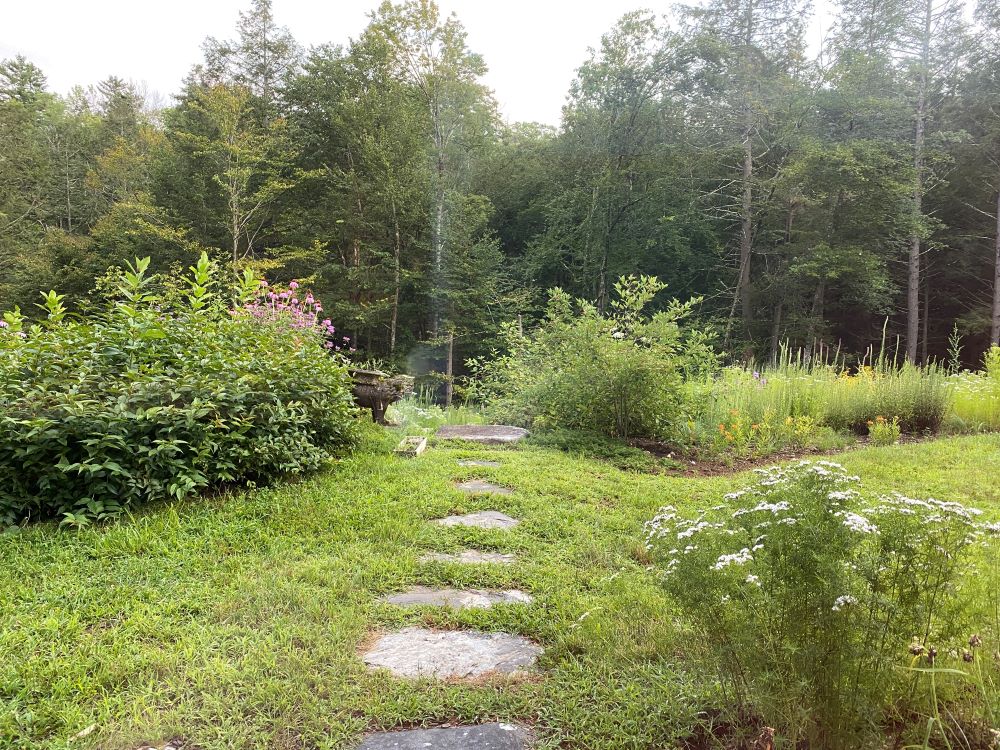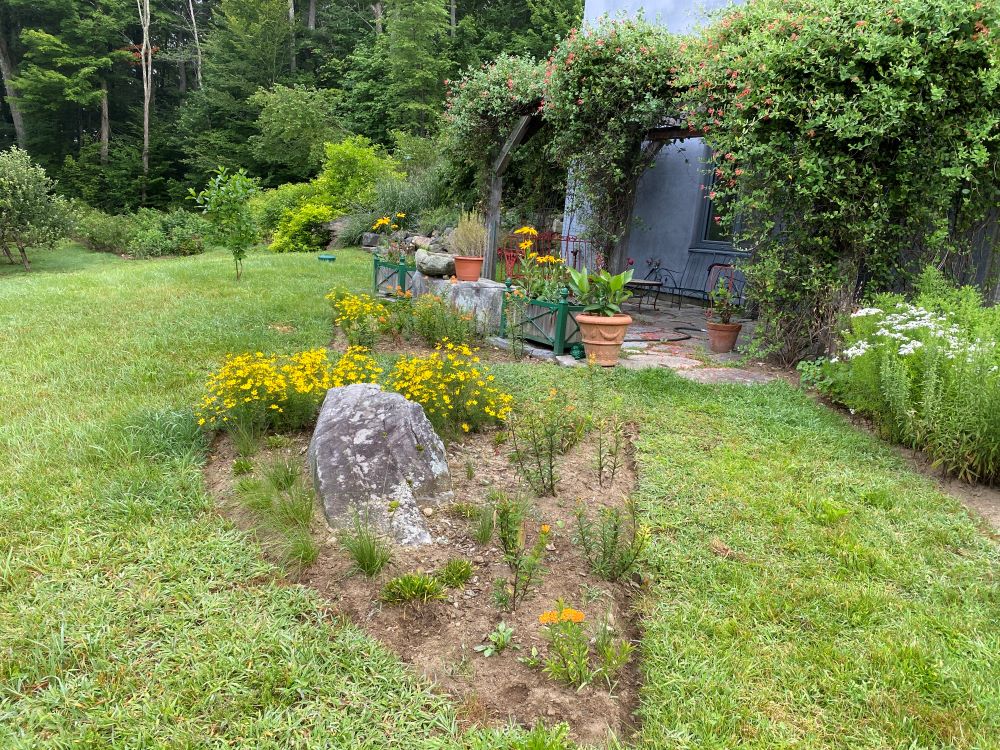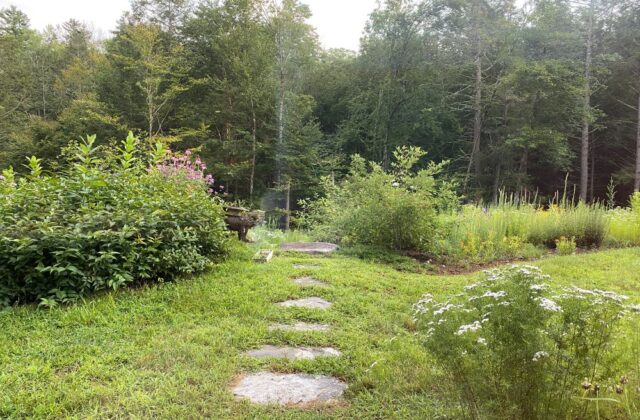Making the Native… Personal
Cheryl Heller Builds a Wild Garden in Norfolk

Masses of native plants meander along a stone path.
By Joe Kelly
Gardens are best when they’re personal, argued the late Fred McGourty, who remains Norfolk’s best- known plantsmen. McGourty’s 1989 book, “The Perennial Gardener,” recounts the gardens he and his wife, Mary Ann, created at Hillside, their home near Dennis Hill State Park.
Were he still with us, Fred would be intrigued and likely a little skeptical about the gardening experiment now underway a short distance from his old home on Litchfield Road. That’s where Cheryl Heller has embarked on one of Norfolk’s largest forays into native-plant gardening.
A Rocky Hillside in the Woods
Pull up to Heller’s house and what makes the garden “native” becomes evident as you spy a line of flowering raspberries. A neglected spot where another gardener might have installed pachysandra is instead home to patches of sedum and St. John’s wort, goats beard and ferns, transplanted from other areas of the property. Stroll around the house and there are wild blueberry, chokeberry, serviceberry and winterberry with a patch of buttonbushes over here, a fringe tree over there and red twig dogwoods in the distance. Drifts of milkweed, columbine and lupine fill the gaps.
All were planted in collaboration with Chris Erickson of Untamed Gardens of Monterey, Mass. And the reason they are being planted in 2024 is because they were likely there in 1624 and earlier. These are the plants that birds and insects have depended on. It’s an ecology that emerged over eons and was disrupted by the arrival of European settlers.
A 1970s-era Manufacturing Plant
Heller came to the area 30 years ago and took up gardening while renovating an 1887 home in Colebrook. About 15 years ago she and her husband, Gary Scheft, decided they wanted a new project and that led them to the Litchfield Road property—94 acres surrounding a 1970s-era cement and steel commercial building that once housed a clothing manufacturer. With Scheft serving as general contractor, they stripped the building down to its studs and completely reimagined it, creating sleeping quarters downstairs and turning the second floor—what had been the primary manufacturing floor—into uninterrupted living space. Standing beneath the high ceilings, looking through the huge windows, you have the sense of being on the deck of a ship sailing into the forest.
The Controlled and the Wild
Much of the garden is on the terraced hillside directly in front of the windows. With the help of Erickson—whose skills were honed restoring prairie landscapes in Minnesota—Heller set about creating a network of grass paths connecting amorphously shaped beds and borders. Erickson put in plugs of mountain mint, aromatic aster, spiderwort and spotted bee balm following basic garden organizational principles: smaller, upright plants in front, larger ones at the back. Compared to McGourty’s Hillside estate, Heller’s garden comes off as wild and untamed. Yet hers is just as organized with layouts to prove it. The tension between controlled and wild is evident throughout the garden and mirrors Heller’s professional life.
Heller began as a painter, became a sought-after communication designer in advertising and branding, but over time found herself less interested in design as a form of self-expression and intrigued more by how it can provide tools, processes and a way of thinking to help address social issues. She refined her ideas through a book (“The Intergalactic Design Guide”) and founded the first graduate program in social design at New York’s School of Visual Arts. Her goal is to help people use design to uncover hidden resources, embrace complexity and create healthy, sustainable environments —which is pretty much what she is also doing with her focus on native plants.
Insects, Birds and Food Deserts
Ecologists have been extolling their virtues of native plants for years, but the movement took on new urgency in 2014 when the World Wildlife Fund documented a precipitous decline in the population of monarch butterflies migrating south to Mexico. Since then, biologists have found declines across a range of insect populations, and a primary culprit is the loss of native plant habitats.
If one seeks to increase the number of monarchs, there’s only one way to do it: plant milkweed, lots of it. The female monarch will only lay her eggs on milkweed. And the caterpillars from those will only eat milkweed leaves. No milkweed, no monarchs.
Similarly, the swallowtail butterfly depends on the sassafras tree and spicebush shrub. Crescent butterflies rely on asters. Birds have been found to fly for miles, ignoring the non-native fruits of invasive shrubs like Japanese barberry, seeking only the berries of native plants. In effect, when native plant habitats give way to non-native species—lawns, ornamental flowers, invasive plants—the result is a food desert.
Heller sees her garden as a mission and an exercise in humility. “You walk around the garden, and you see all of these interconnections and you’re constantly reminded nature is not hierarchical. We are not at the top. We’re just another part of the ecosystem but one that has assumed extraordinary power.”
But can a wild, unruly, untamed garden of native plants also be “personal” as McGourty recommended?
Heller barely misses a beat: “I’m not sure in these times that the question anymore is, How do you make your garden personal? I think the question is, How do you learn from your garden to create a personal relationship with nature?”

Coreopsis and yarrow line a path to an arbor covered with blooming (native) honeysuckle.

